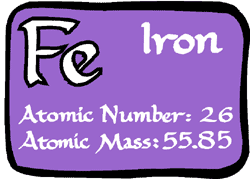|
|
 |
|
1. The importance of iron
In the texts about „Oceanic Nutrients“ you found out that iron is not only a raw material but that it is very important for the life of many organisms.
Exercise: Gather information about the basic chemical properties of iron and its importance as nutrient from the internet or an encyclopaedia.
|
 |
 |
Iron, Cliparts 1 & 2 from Hemera, Big Box of Art |
|
 |
|
|
Iron is also an important nutrient for humans. Their daily need of iron is 10-15 mg.
This is a relatively small amount which normally is supplied by food.
|
Exercise: Which food does contain high amounts of iron?
The following link may help you: www.vegetarismus.ch/info/e17.htm
|
 |
|
|
Iron helps to create the red blood pigment haemoglobin and activates the creation of skin and mucosa cells.
|
 |
 |
|
Clipart 3 by Hemera, Big Box of Art
|
|
 |
The consequences of lack of iron can be anaemia, pale skin, headache, symptoms of fatigue, vertigo, loss of hair and disorders of the stomach.
|
|
2. Transportation of Iron
Iron is blown, together with the dust, from the great deserts of the world into the sea. There it serves as a nutrient for phytoplankton.
The following picture shows you the major routes of the dust transportation. Klick in the picture to enlarge it (152 kb).
|
 |
 |
|
2. Advanced Very High Resolution Radiometer (AVHRR) images of particle transport in the atmosphere between June and August. These images show the major dust transport routes across the Atlantic and Indian Oceans. As they measure all particles in the air, they also show particles coming off southwest Africa from biomass burning and pollutants coming off the eastern coast of North America. Copyright American Geophysical Union. Click on the picture for a better view (151 kb).
|
|
The dust together with the iron is brought to the sea and to different continents, covering huge distances.
It even happens several times a year that big clouds of dust are blown from the Sahara to Central Europe.
|
Calculation exercise:
How fast do dust particles move by the wind?
Within the text it is mentioned that dust particles need about one week to cross the Atlantic Ocean.
Calculate the average speed in km/h, assuming that the distance from the Sahara to the American East coast is 7000 km!
|
 |
 |
 |
|
Clipart 4 by Hemera, Big Box of Art
|
|
Exercise
Let´s test, if you got the message from the text:
Click the GREEN button, if you think that the answer is correct
and the RED button, if you think that the statement is wrong.
|
a) Iron constitues 20% of the Earth's crust.
|
 |
|
b) Iron is mainly transported by dust into the seas.
|
 |
|
c) All seas which have a small amount of phytoplankton are close to deserts.
|
 |
|
d) The dust, which supplies the seas with iron, basicly comes from the arid areas of the Northern hemisphere.
|
 |
|
e) The lowest concentration of dust can be measured above the South Seas near the Antarctica.
|
 |
|
f) Dust particles are blown at a height of 50 meters above the Atlantic Ocean.
|
 |
|
g) Dust particles either fall as dry particles into the sea or are integrated in raindrops.
|
 |
|
h) Iron is not very soluble in water and is usually found in iron-III-compounds.
|
 |
|
i) The areas, which have a high concentration of phytoplankton are called HNLC-Regions
(regions with a high amount of nutrients like nitrate and phosphate, but little chlorophyll).
|
 |
|
j) HNLC-Regions are far away from the huge deserts of the world.
|
 |
|
About this page:
- Author: - Bernd Wohlhöfer - University of Nürnberg - Germany
- scientific reviewing:
- educational reviewing: Prof. Dr. Schrettenbrunner / Dr. Schleicher / J. Heres
- last update: 07/20/04
|
|
 |
|









